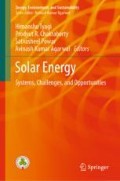Abstract
Solar updraft tower power plant is a way to harness energy from the sun. It is a simple concept which requires low maintenance and utilises land that is already being used for growing plants, and generates power from it. A prototype plant was setup in Manzanares, Spain. Numerical analysis on power generation is performed for a similar plant assuming it is setup in Ropar. By considering losses via convection and radiation through the top surface of the collector, collector efficiency is calculated. Two cases arise here, 1. With 100% collector efficiency and 2. Collector efficiency is obtained after subtracting convection and radiation losses. The influx of solar radiation is highest in June. Hence, the variation of parameters like temperature, velocity, power output, efficiency with time of the day is done by taking averages for the month of June. Next the impact of physical parameters like chimney height, chimney radius and collector radius are studied on 21st June 11:00 to 12:00. How each parameter impacts the output of the plant is studied by creating a mathematical model of the power plant. Methods to improve the power output are discussed.
Access this chapter
Tax calculation will be finalised at checkout
Purchases are for personal use only
Abbreviations
- A :
-
Area (m2)
- C :
-
Power coefficient for wind turbine, C = 0.45
- C p :
-
Specific heat at constant pressure for air (J/kg K), Cp = 1007 J/kg K
- g :
-
Acceleration due to gravity (m/s2), g = 9.81 m/s2
- G sc :
-
Solar constant (W/m2), Gsc = 1367 W/m2
- h :
-
Convective heat transfer coefficient (W/m2 K)
- H :
-
Height (m)
- I o :
-
Hourly incident solar energy on an extra-terrestrial horizontal surface (J/m2)
- m :
-
Refractive index
- ṁ :
-
Mass flow rate of air (kg/s)
- n :
-
Day of the year
- p :
-
Pressure (Pa)
- P :
-
Power (kW)
- Q :
-
Heat (W)
- Q″:
-
Hourly average incident heat flux (W/m2)
- r :
-
Radius (m)
- R :
-
Characteristic gas constant (J/kg K), R = 287 J/kg K
- T :
-
Temperature (°C)
- v :
-
Velocity (m/s)
- ε :
-
Emissivity
- η :
-
Efficiency (%)
- ρ :
-
Density (kg/m3)
- σ :
-
Stefan-Boltzmann’s constant (W/m2 K4), σ = 5.67 × 10−8 W/m2 K4
- τ :
-
Transmissivity
- chim :
-
Chimney
- coll :
-
Collector
- conv :
-
Convection
- i :
-
Inlet of turbine/chimney
- o :
-
Ambient
- ovr :
-
Overall
- rad :
-
Radiation
- turbine :
-
Turbine
References
Agarwal A, Kumar P, Mehta B (2018) Solar updraft tower—a potential for future renewable power generation: a computational analysis. In: Tyagi H, Agarwal AK, Chakraborty PR, Powar S (eds) Applications of solar energy. Springer, Singapore, pp 319–339
Chitsomboon T (2001) A validated analytical model for flow in solar chimney
Duffie JA, Beckman WA (2003) Solar radiation
Fasel HF, Meng F, Shams E, Gross A (2013) CFD analysis for solar chimney power plants. Sol Energy 98:12–22
Haaf W (1984) Solar chimneys. Part II: preliminary test results from the Manzanares pilot plant. Int J Sol Energy 2(2):141–161
Haaf W, Friedrich K, Mayr G, Schlaich J (1983) Part I: principle and construction of the pilot plant in Manzanares. Int J Sol Energy 2(1):3–20
Incropera FP, Dewitt DP, Bergman TL, Lavine AS (1993) Fundamentals of heat and mass transfer
Koonsrisuk A, Chitsomboon T (2013) Mathematical modeling of solar chimney power plants. Energy 51:314–322
Lodhi MAK (1999) Application of helio-aero-gravity concept in producing energy and suppressing pollution. Energy Convers Manag 40(4):407–421
Pasumarthi N, Sherif SA (1998a) Experimental and theoretical performance of a demonstration solar chimney model—Part II: experimental and theoretical results and economic analysis. Int J Energy Res 22(5):443–461
Pasumarthi N, Sherif SA (1998b) Experimental and theoretical performance of a demonstration solar chimney model—Part I: mathematical model development. Int J Energy Res 22(3):277–288. Fuel Energy Abstr 39(3):201
Schlaich J (1996) The solar chimney: electricity from the sun, p 55
Schlaich J, Bergermann R, Schiel W, Weinrebe G (2005) Design of commercial solar updraft tower systems—utilization of solar induced convective flows for power generation. J Sol Energy Eng 127(1):117
Shahzad U (2012) The need for renewable energy sources. ITEE J 1(1):30–38
Zandian A, Ashjaee M (2013) The thermal efficiency improvement of a steam rankine cycle by innovative design of a hybrid cooling tower and a solar chimney concept. Renew Energy 51:465–473
Acknowledgements
The authors (K. V. S. T., K. G. and H. T.) wish to express their gratitude to the School of Mechanical Material and Energy Engineering at Indian Institute of Technology Ropar for their support.
Author information
Authors and Affiliations
Corresponding author
Editor information
Editors and Affiliations
Rights and permissions
Copyright information
© 2020 Springer Nature Singapore Pte Ltd.
About this chapter
Cite this chapter
Teja, K.V.S., Garg, K., Tyagi, H. (2020). Mathematical Modelling of Solar Updraft Tower. In: Tyagi, H., Chakraborty, P., Powar, S., Agarwal, A. (eds) Solar Energy. Energy, Environment, and Sustainability. Springer, Singapore. https://doi.org/10.1007/978-981-15-0675-8_7
Download citation
DOI: https://doi.org/10.1007/978-981-15-0675-8_7
Published:
Publisher Name: Springer, Singapore
Print ISBN: 978-981-15-0674-1
Online ISBN: 978-981-15-0675-8
eBook Packages: Chemistry and Materials ScienceChemistry and Material Science (R0)

